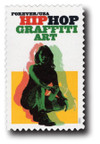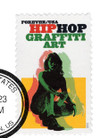
# 5482 - 2020 First-Class Forever Stamp - Hip Hop: Graffiti Art
US #5482
2020 Graffiti Art – Hip Hop
• One of four stamps commemorating the creativity and far-reaching influence of hip hop on the world of music
Stamp Category: Commemorative
Set: Hip Hop
Value: 55¢ First Class Mail Rate (Forever)
First Day of Issue: July 1, 2020
First Day City: New York, New York
Quantity Issued: 20,000,000
Printed by: Ashton Potter (USA) Ltd.
Printing Method: Offset
Format: Panes of 20
Tagging: Nonphosphored Type III, Block Tag
Why the stamp was issued: To recognize the significance of graffiti art to the genre of hip hop music.
About the stamp designs: Pictures a photograph of a graffiti artist taken by Cade Martin and accented by digital tinting (yellow, green, red, and black) to make the image appear to be in motion.
First Day City: There was no First Day of Issue Ceremony for these stamps, but the First Day of Issue Cancellation was from New York City.
About the Hip Hop set: Four stamps celebrating the legacy of hip hop music and its influence on American and world popular culture. All picture photographs taken by Cade Martin that have been accentuated by digital tinting (yellow, green, red, and black) to make them appear to be in motion.
History the stamp represents: Graffiti is the visual aspect of hip hop. It can be found hidden in out-of-the-way places and covering massive walls. While some consider graffiti to be vandalism, others consider it to be an art form. Graffiti has a long history, dating back centuries…
The word graffiti comes from the Italian word graffiato (“scratched”). Through much of history, it referred to figure drawings on the walls of ancient ruins, such as those found in the Catacombs of Rome and Pompeii. Ancient graffiti carried declarations of love, political messages, insults, alphabets, and quotes.
Early examples of modern graffiti include messages left by hobos and rail workers on train cars in the late 1800s. Graffiti as a form of urban art began to appear in the 1950s. Graffiti became associated with hip hop in the 1970s as a way for groups to “tag” their neighborhoods. Soon, graffiti artists spray painted walls at block parties while DJs played music. And the appearance of graffiti in music videos helped to further link the visual art to hip hop culture.
While early graffiti consisted of quickly sprayed signatures, it has grown into elaborate calligraphy and images with effects, shading, and more. Though some still consider it vandalism, others see graffiti as art. In fact, a graffiti artist that was once chased by authorities recently sold one of their works for $100 million.
US #5482
2020 Graffiti Art – Hip Hop
• One of four stamps commemorating the creativity and far-reaching influence of hip hop on the world of music
Stamp Category: Commemorative
Set: Hip Hop
Value: 55¢ First Class Mail Rate (Forever)
First Day of Issue: July 1, 2020
First Day City: New York, New York
Quantity Issued: 20,000,000
Printed by: Ashton Potter (USA) Ltd.
Printing Method: Offset
Format: Panes of 20
Tagging: Nonphosphored Type III, Block Tag
Why the stamp was issued: To recognize the significance of graffiti art to the genre of hip hop music.
About the stamp designs: Pictures a photograph of a graffiti artist taken by Cade Martin and accented by digital tinting (yellow, green, red, and black) to make the image appear to be in motion.
First Day City: There was no First Day of Issue Ceremony for these stamps, but the First Day of Issue Cancellation was from New York City.
About the Hip Hop set: Four stamps celebrating the legacy of hip hop music and its influence on American and world popular culture. All picture photographs taken by Cade Martin that have been accentuated by digital tinting (yellow, green, red, and black) to make them appear to be in motion.
History the stamp represents: Graffiti is the visual aspect of hip hop. It can be found hidden in out-of-the-way places and covering massive walls. While some consider graffiti to be vandalism, others consider it to be an art form. Graffiti has a long history, dating back centuries…
The word graffiti comes from the Italian word graffiato (“scratched”). Through much of history, it referred to figure drawings on the walls of ancient ruins, such as those found in the Catacombs of Rome and Pompeii. Ancient graffiti carried declarations of love, political messages, insults, alphabets, and quotes.
Early examples of modern graffiti include messages left by hobos and rail workers on train cars in the late 1800s. Graffiti as a form of urban art began to appear in the 1950s. Graffiti became associated with hip hop in the 1970s as a way for groups to “tag” their neighborhoods. Soon, graffiti artists spray painted walls at block parties while DJs played music. And the appearance of graffiti in music videos helped to further link the visual art to hip hop culture.
While early graffiti consisted of quickly sprayed signatures, it has grown into elaborate calligraphy and images with effects, shading, and more. Though some still consider it vandalism, others see graffiti as art. In fact, a graffiti artist that was once chased by authorities recently sold one of their works for $100 million.








